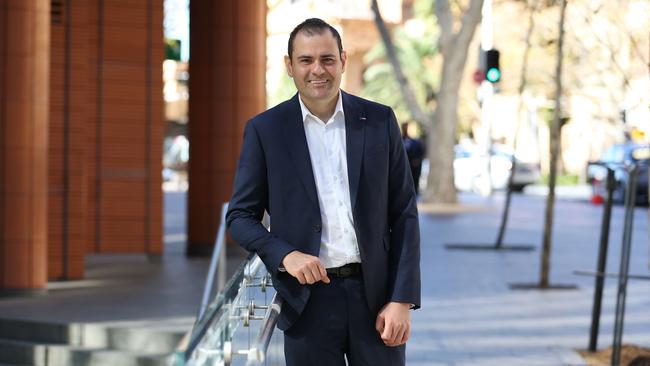Next-generation battery pioneer Imperium3 could prove underpowered
Are Imperium3’s hi-tech battery promises too good to be realised?

A house on the road to Heathrow Airport seems an unlikely place to find the headquarters of a company that has purportedly struck a major agreement to buy the next-generation batteries being developed by the industry’s star player, Imperium3.
But that is where you will find the premises of Sukh Energy, net assets £100, one of a handful of firms that appears to make up a $US665m ($904m) order book that underpins Imperium3’s recent success.
Any success for Imperium3 is shared by ASX-listed Magnis Energy, which owns a 63 per cent stake in the New York-based manufacturer and a 10 per cent stake in the related Charge CCCV, whose patented intellectual property underpins the ultra-fast charging batteries. It has been a long road for Magnis, now valued at around $320m, which first floated in 2005 and spent its first decade on speculative projects, most recently graphite in Tanzania.
Since that time it has attracted some significant names onto its board, including former Macquarie executive Warwick Smith, who left after a year, former NSW deputy premier Troy Grant, who stayed just eight months, and McGrath Estate Agents founder James Dack, who departed 11 months in. It’s also raised large amounts of money, most recently securing $20m from funds linked with mining scion John Hancock.
At its core, the Magnis proposition is simple. Next-generation batteries will be able to quickly power everything from New York’s public transportation system to the US military. C4V, as it is known, will supply the knowledge and Imperium3 will build it.
The new technology, the company claims, could recharge electric cars in just a few minutes without damaging batteries – which would be made without expensive cobalt and nickel.
But exactly who Imperium3’s customers are is just one question being asked about Magnis – along with how much store investors should place in the company’s optimistic public commentary.
On Thursday, one day after being approached by The Australian, Magnis was forced to make a startling clarification. Back in April, the company told investors that Imperium3 had received a $US50m loan from American firm Riverstone Credit Partners, finally giving it the funding needed to complete development of a lithium-ion “gigafactory” in Endicott, a small town in upstate New York known as the “birthplace of IBM” for its association with the forerunner of the technology giant.

And a week later, Magnis chairman Frank Poullas said it was “exciting” to announce Riverstone had separately taken a $US5m stake in C4V, a “commitment” to the project. Part of those proceeds would be used to pay back an earlier loan from Magnis.
“We are very thankful to Magnis … for supporting C4V and making the (Imperium3) battery plant a high-priority project which has played a significant role in advancing both groups,” said Shailesh Upreti, the chairman of both C4V and Imperium3.
But there was no share purchase.
The $US50m loan was actually a $US63m “delayed-draw term loan”. And the $US5m in C4V shares Riverstone received? It was a fee. In fact, the fee was $US10m. Riverstone received the same value of shares in Imperium3. In all, a very expensive loan.
“Magnis … has been made aware of a discrepancy in an announcement made on 28 April 2021,” the company wrote in an ASX statement released on Thursday.
“The Announcement reflected the Company’s misunderstanding that Riverstone Credit Partners received a 3.5% interest in C4V as consideration for US$5 Million.”
Factory delays
There’s little doubt that Magnis’ main Endicott-based battery plant has been seriously delayed.
It was first announced by the then New York governor Andrew Cuomo in 2017 and was scheduled to open by the end of 2019. It was expected to produce 15 gigawatts of lithium-ion batteries.
In May this year, after announcing Imperium 3 had signed orders worth at least $US665m, Magnis disclosed the New York plant’s production capacity was being “increased” to just 1.8 gigawatts per year. In August, Magnis said construction of the plant was now 18 per cent finished.
It expects to open sometime in 2022 – at least three years late. The company has produced its first lithium-ion battery cell at the facility. By hand.
Magnis has also refused to disclose who has entered into binding agreements to buy the $US665m in batteries from Imperium3 when the plant is up and running. Those orders were first released to the ASX on May 3, despite Imperium3 submitting a report to a New York government agency on April 9 – almost an entire month earlier – disclosing that “contracts have been initiated with 6 signed customers to date … customers nearing $US650m”.
A Magnis spokesman said all contracts had been provided to the ASX before the May 3 announcement. “The agreements contain clauses requested by the client relating to their details being confidential,” the spokesman said. (The ASX told The Australian it had no objections under the listing rules to Magnis’ release of the announcement.)
“Regarding any announcements – the company has continuous disclosure requirements and makes announcements as soon as it’s aware of any information,” Magnis, whose chairman Frank Poullas sits on the boards of Imperium3 and C4V, told The Australian.
(Poullas later told The Australian that the New York factory was likely to be operating “at decent scale” by April 2022.)
So far, the company has yet to book any revenue.
IP issues
Shailesh Upreti, chairman of Imperium3, was first educated in Uttarakhand, a northern Indian state in the foothills of the Himalayas. After graduating from the Indian Institute of Technology Delhi, he found himself at Binghamton University, near the border between New York and Pennsylvania.
As a postdoctoral fellow, Upreti was heavily involved in the commercialisation of next-generation battery technology. His intellectual property became the basis for C4V, and by 2017, he had secured enough funding to get Imperium3 off the ground.
Magnis, meanwhile, progressively increased its stake in the two companies, most recently increasing its stake in Imperium with $US36.6m of new funding this year.
And Magnis has loudly touted Upreti’s research. In March, it praised its investment in the “leading US-based, lithium-ion battery technology group” C4V, and said it had “an exclusive agreement for five years over selective patents, which will assist in driving the company’s growth”.
Magnis has not disclosed significant details about this intellectual property.
But in February 2018, an investor presentation did list 17 patents covering its “next generation anode and cathode battery materials … in over 35 countries”.
An analysis by The Australian has raised some questions about these patents – and how exclusive the intellectual property really is.
Of the six US patents listed in Magnis’ 2018 presentation, two are not legal patents.
The two Chinese patents are currently owned by Charge Energy Co. Its relationship with C4V is unclear.
Poullas and Magnis both say the ownership of the patents has been thoroughly vetted, including earlier this year when the Riverstone loan was secured.
“(Riverstone) had patent attorneys on the case, and we went through a process which, between Riverstone and HSBC, had 20 months of (due diligence) before we got the (loan) deal done,” Poullas told The Australian.
In response to questions, a Magnis spokesman said Charge CCCV was the “sole owner of all the patents, and as per founder’s agreement for all cell materials technology, Shailesh develops would be assigned to C4V”.
“C4V has provided an exclusive licence around the Anode to Magnis as was announced in 2018 which allows the company to use that technology for the manufacturing of that component. That component is then supplied to (Imperium3) only in the US market, but can be sold to groups outside of the US,” he said.


But Magnis isn’t the only company touting an “exclusive’ arrangement with C4V.
EnergyLink3, a company on whose board Upreti sits, notes online that it “has an exclusive licence of C4V battery management and energy management systems, to support the United States Department of Defence … EnergyLink3 has supply agreement with (Imperium3) for cobalt and nickle (sic) free lithium ion cells and looking forward to integrating those into mission critical systems”.
Investor troubles
Warwick Smith was appointed to the company’s board in September 2018 when the fund he chaired, AL Capital, took an $11m stake in Magnis. It was, by all accounts, an unhappy investment.
Smith, a former federal Coalition government minister, had serious concerns about the company’s US operations. He was replaced as AL Capital’s nominee director by Subhas DeGamia in January 2020.
DeGamia departed the board a month later, and AL Capital offloaded its shareholding.
Smith declined to comment on Monday. He was not the only prominent name to leave on bad terms. The Sunday Telegraph reported in May that Dack, son-in-law to Hungry Jack’s billionaire Jack Cowin, had consulted with lawyers after he departed Magnis that month.
Despite these troubles, Magnis has found other investors.
Last month, it secured the backing of the SBC Global Investment Fund and Lind Partners – an alternative asset manager advised by John Hancock, the son of mining magnate Gina Rinehart.
“Companies that can deliver better-performing batteries at scale will be rewarded with market share, and we look forward to being part of Magnis’ journey in this space,” Hancock said.
That investment – allowing Lind and SBC access to an enormous number of shares at just 25c a piece – has become a goldmine for the Hancock-advised parties.
On August 4, one day after the deal was announced, Magnis told the ASX it had secured another $US74m order for batteries from the New York plant. The company’s share price rose from 28c to more than 40c in less than a week. And despite enthusiasm for Magnis’ long-term future, the investors cashed in.
Between August 6 and August 13, with the share price fluctuating between 39c and 42c, the two investors were issued more than 71 million shares – at 25c. Of those, they still own just 17 million.
Poullas said: “From their point of view there was an opportunity on the terms of the deal. The fact that John Hancock sort of has that association with (the investors), and it’s out in the media as well, gets the price moving.
“From their side it was an opportunity,” he said on Monday.
“From our side, you’d want (them) to convert at high prices.”



To join the conversation, please log in. Don't have an account? Register
Join the conversation, you are commenting as Logout